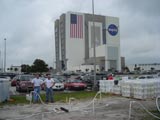
NASA Selects In-situ Chemical Oxidation for Leak Cleanup
 The National Aeronautics and Space Administration's Kennedy Space Center in Cape Canaveral, Fla., has undertaken aggressive groundwater and soil remediation to treat an area of on-site petroleum hydrocarbon contamination using RegenOx™, a proven non-corrosive and cost-effective in-situ chemical oxidation technology developed by Regenesis of San Clemente, Calif.
The National Aeronautics and Space Administration's Kennedy Space Center in Cape Canaveral, Fla., has undertaken aggressive groundwater and soil remediation to treat an area of on-site petroleum hydrocarbon contamination using RegenOx™, a proven non-corrosive and cost-effective in-situ chemical oxidation technology developed by Regenesis of San Clemente, Calif.
The Launch Equipment Shop, part of NASA's famed Vehicle Assembly Building complex, has conducted highly specialized manufacturing, fabrication, and assembly work for the space program since the early 1960s. Leaks from a 4,000-gallon underground fuel oil tank, subsequently decommissioned and removed, led to notable contamination of soil and groundwater, including a layer of light non-aqueous phase liquid up to 15 inches thick, with total recoverable petroleum hydrocarbon (TRPH) levels as high as 20,000 parts per million (ppm) in soil and 42 ppm in groundwater. The tank and 178 tons of readily accessible contaminated soil were excavated and properly disposed of early on, but other, harder-to-reach contaminated soils had to be left in place beneath and near building foundations, where essential underground utilities were located. NASA's consultant, Tetra Tech, identified excavation as the preferred approach for remediating the remaining contamination, but the cost of excavating the hard-to-reach soils was prohibitive, at more than $1 million. After examining alternative remediation technologies, in-situ chemical oxidation (the application into the subsurface of highly reactive chemicals, which chemically oxidize and destroy contaminants on contact) was chosen as a more cost effective means of site remediation. Most conventional in-situ chemical oxidation chemistries were ruled out, however, due to their corrosivity and tendency to generate intense heat and/or explosive pressures.
RegenOx, a commercially available, two-part product, was a suitable alternative. It includes an alkaline oxidizer powder and a liquid activator. When combined, they produce a cascade of chemical oxidation reactions that effectively destroy a range of contaminants but do not pose a destructive risk to subsurface infrastructure and other equipment.
Tetra Tech injected approximately 137,000 gallons of RegenOx into the site via 52 injection wells. After treatment, the area of TRPH-impacted soils was reduced to approximately one-fourth of its original size. Site-wide groundwater contaminant concentrations of TRPH also were reduced substantially, and the thickness of the free-product layer was reduced by 80 percent.